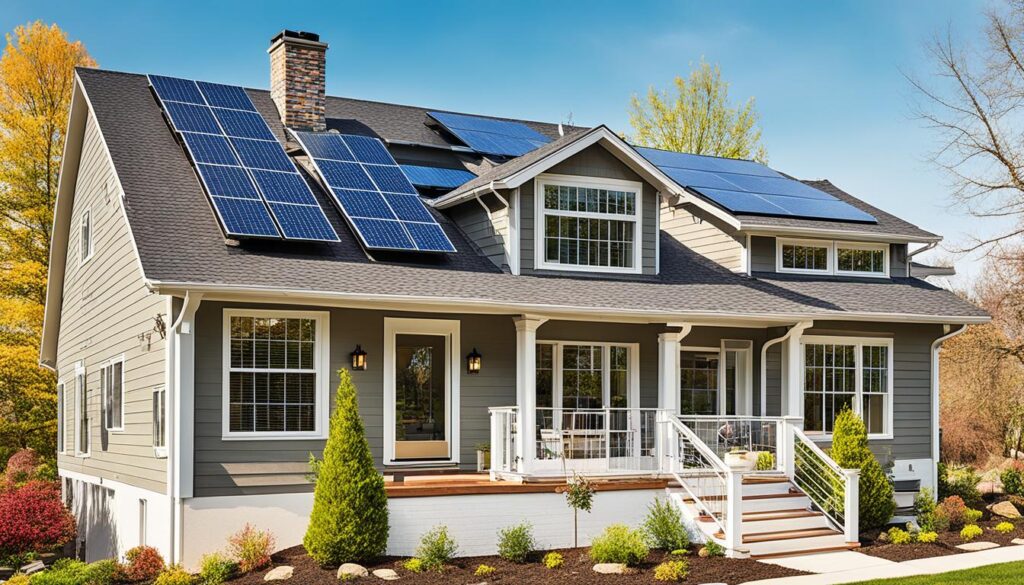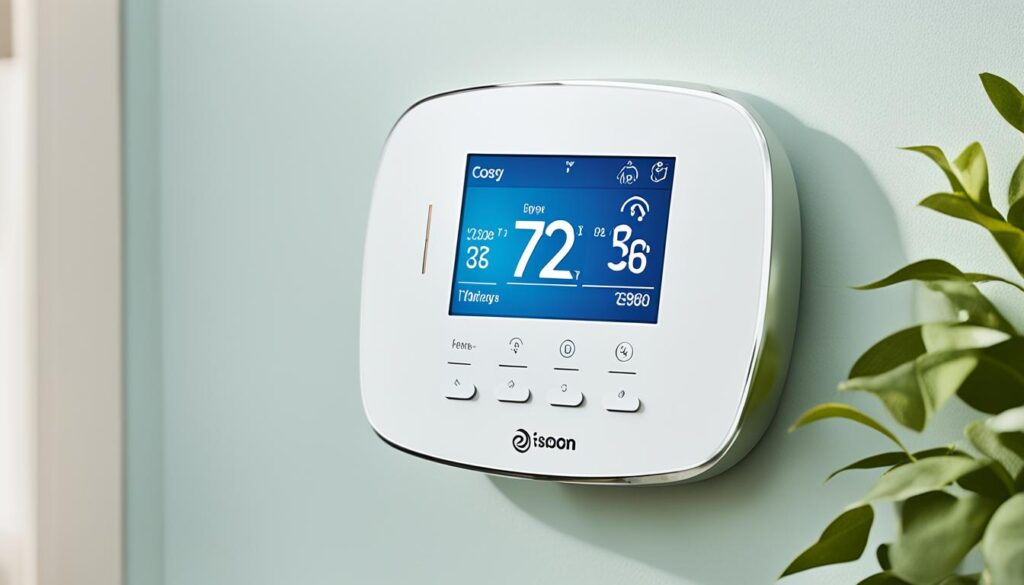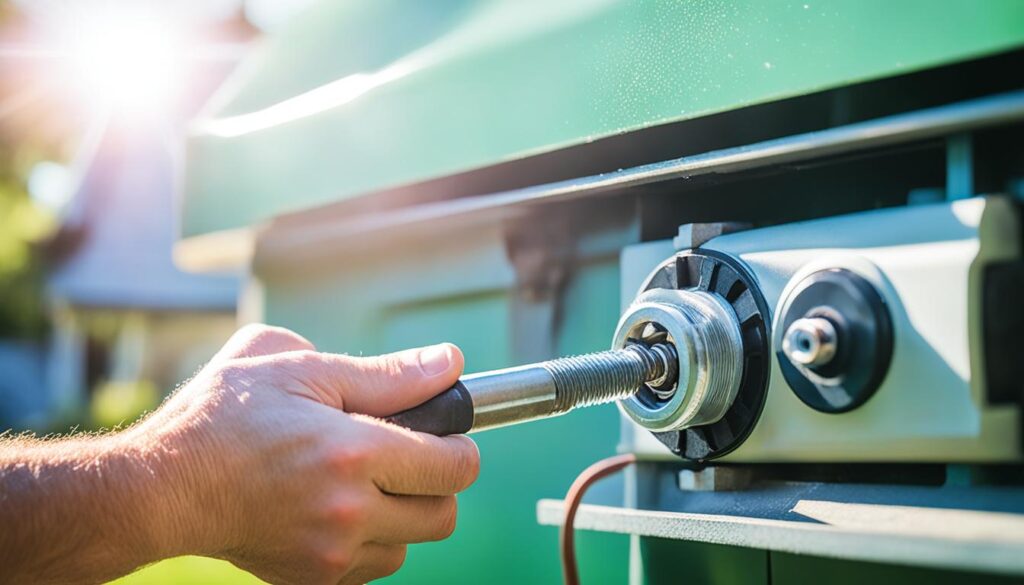Welcome spring with energy-efficient home upgrades that lower bills and benefit the planet. In this article, we will explore a variety of strategies and tips to help you save energy in your home during the spring season. These energy-efficient upgrades will not only help you save money but also contribute to a more sustainable future. Let’s dive into the details and discover how you can make your home more eco-friendly this spring.

Key Takeaways:
- Implementing energy-efficient upgrades in your home can lead to significant cost savings and a reduced carbon footprint.
- Conduct an energy assessment to identify areas where you can make the most impact and prioritize your upgrades accordingly.
- Utilize window coverings to prevent heat gain and reduce the need for air conditioning.
- Optimize your thermostat settings and consider installing a programmable thermostat for efficient temperature control.
- Embrace natural ventilation, fans, and exhaust fans to cool your home without relying solely on air conditioning.
With these simple and cost-effective strategies, you can make your home more energy-efficient and environmentally friendly this spring. By taking steps to reduce energy consumption, you not only contribute to a greener future but also save money in the process. So, let’s get started on your spring home improvements and make a positive impact on the planet.
Conduct an Energy Assessment for Maximum Savings
Before you start making energy-efficient upgrades to your home, it’s important to conduct an energy assessment. This assessment will help you identify areas where you can save the most energy and prioritize your upgrades. By understanding your home’s energy usage, you can make informed decisions about the most cost-effective energy upgrades for your specific needs.
Consider hiring a professional energy auditor or use online tools and resources to conduct a DIY assessment. An energy assessment involves evaluating various aspects of your home, including insulation, appliances, lighting, and HVAC systems. The auditor will analyze your energy bills, inspect your home’s structure, and use specialized equipment to assess energy usage.
During the energy assessment, the auditor will identify areas of improvement, such as air leaks, inadequate insulation, or outdated appliances. They will also provide recommendations for energy-saving measures, which may include installing efficient appliances, upgrading insulation, or sealing air leaks.
By conducting an energy assessment, you can gain valuable insights into your home’s energy efficiency and discover opportunities to save energy and reduce your utility bills. Whether you’re looking to save money or reduce your environmental impact, an energy assessment is the first step towards achieving your goals.
“Conducting an energy assessment allows homeowners to pinpoint areas where they can make the most significant impact when it comes to saving energy and reducing costs. It’s an essential first step towards creating an energy-efficient home.”
– Jane Anderson, Energy Efficiency Expert
Take control of your energy consumption by conducting an energy assessment today. Discover the potential for cost-effective energy upgrades and enjoy the benefits of a more energy-efficient home.
Energy Assessment Checklist
| Areas to Evaluate | Potential Upgrades |
|---|---|
| Insulation | Upgrade to higher R-value insulation Add weatherstripping to doors and windows |
| Appliances | Replace outdated appliances with energy-efficient models Consider ENERGY STAR-rated options |
| Lighting | Switch to LED light bulbs Install dimmer switches and timers |
| HVAC System | Upgrade to an energy-efficient heating and cooling system Set programmable thermostats |
| Air Leaks | Seal air leaks around doors, windows, and ducts Add insulation to walls and attics |
| Water Heating | Insulate water heater and hot water pipes Install low-flow showerheads and faucets |
Utilize Window Coverings for Heat Prevention
During the scorching spring days, preventing heat gain in your home can significantly reduce the need for excessive air conditioning and help you save energy. One effective and cost-efficient way to achieve this is by utilizing window coverings. By installing energy-efficient window treatments, such as blinds, curtains, or shades, you can block out the sun’s rays and keep your home cooler throughout the day.
Energy-efficient window coverings not only provide relief from the heat but also offer insulation and UV protection, maximizing their efficiency. These window treatments help in creating a comfortable indoor environment while reducing your reliance on energy-consuming cooling systems.
Benefits of Energy-Efficient Window Coverings
Energy-efficient window coverings offer several advantages:
- Prevent heat gain: These coverings block solar heat, preventing it from entering your home and keeping your interiors cooler.
- Reduce cooling costs: By minimizing heat gain, energy-efficient window treatments alleviate the burden on your air conditioning system, resulting in lower energy bills.
- Enhance insulation: Window coverings with insulating properties offer an additional barrier against heat transfer, helping maintain a comfortable temperature inside your home.
- Protect against UV rays: Energy-efficient window coverings can also block harmful ultraviolet (UV) rays, safeguarding your furniture, flooring, and artwork from sun damage.
Choosing the Right Energy-Efficient Window Coverings
When selecting window treatments for heat prevention, consider the following:
- Material: Opt for window coverings made from insulating materials like cellular shades or blackout curtains. These materials effectively trap air and reduce heat transfer.
- Color: Light colors reflect sunlight and heat, while darker shades absorb them. If you prefer dark-colored coverings, ensure they have a white or light backing to reflect heat.
- Opacity: Choose window treatments with high opacity levels to block a significant amount of sunlight.
- Adjustability: Consider coverings with adjustable features like tilt-able slats or adjustable shades, allowing you to control the amount of light and heat entering your home.
Summary
Window coverings play a crucial role in preventing heat gain and keeping your home cool during the spring. By utilizing energy-efficient window treatments, you can reduce dependence on air conditioning, save energy, and create a more comfortable indoor environment. Choose coverings that offer insulation, UV protection, and customizable features for optimal heat prevention and energy efficiency.
Optimize Your Thermostat Settings
When it comes to saving energy and reducing costs, optimizing your thermostat settings is crucial. By implementing simple adjustments, you can enhance thermostat efficiency and promote energy-saving thermostat settings. Here are some key tips to help you maximize your thermostat’s functionality:
- Set the Right Temperature: Find a comfortable temperature that suits your needs while minimizing the difference between indoor and outdoor temperatures. This helps reduce the workload on your cooling or heating system and enhances energy efficiency.
- Consider a Programmable Thermostat: Installing a programmable thermostat allows you to automate temperature adjustments based on your daily routine. This way, you can save energy when you’re away from home or sleeping without sacrificing comfort.
By optimizing your thermostat settings, you have the power to reduce energy waste and lower your utility bills. Take advantage of technology and embrace energy-saving solutions for a greener and more efficient home.

“By optimizing your thermostat settings, you have the power to reduce energy waste and lower your utility bills.”
Embrace Natural Ventilation and Fans
When it comes to keeping your home cool during the spring season, natural ventilation and fans can be your allies. By utilizing these energy-efficient cooling strategies, you can create a comfortable living space while reducing your reliance on air conditioning. Let’s explore some tips on how to make the most of natural ventilation and fans in your home:
Open Windows for Fresh Air and a Cooling Breeze
Take advantage of the pleasant spring weather by opening your windows to allow fresh air to circulate throughout your home. Natural ventilation not only improves indoor air quality but also creates a cooling breeze that can help lower your indoor temperature. Embrace the cross-ventilation effect by strategically opening windows on opposite sides of your home to encourage a refreshing airflow.
Install Ceiling Fans for a Wind Chill Effect
Ceiling fans are an excellent addition to any room, providing a cost-effective way to stay cool and comfortable. By creating a wind chill effect, ceiling fans can make you feel up to four degrees cooler, allowing you to raise your thermostat setting and save energy. Make sure to set your ceiling fans to rotate counterclockwise during the summer months for maximum cooling benefits.
Use Exhaust Fans in Bathrooms and Kitchens
During the spring season, humidity and heat can build up in bathrooms and kitchens, making these areas feel uncomfortable. By using exhaust fans in these spaces, you can effectively remove excess moisture, heat, and odors, reducing the need for air conditioning. Make sure your bathroom and kitchen fans are vented to the outside to expel the hot air effectively.
| Benefits of Natural Ventilation and Fans |
|---|
| Reduces reliance on air conditioning |
| Improves indoor air quality |
| Creates a cooling breeze |
| Can lower indoor temperature |
| Cost-effective cooling solution |
“Embrace natural ventilation and fans to keep your home cool and comfortable this spring. Opening windows, installing ceiling fans, and using exhaust fans in bathrooms and kitchens are effective strategies to reduce energy consumption while enjoying a refreshing living environment.”
By embracing natural ventilation and utilizing fans in your home, you can enjoy a cool and comfortable living space while reducing your energy consumption. These energy-efficient cooling strategies not only save you money on your utility bills but also contribute to a more sustainable lifestyle. So, let the fresh air in and feel the breeze!
Maintain Your Cooling System for Efficiency
Keeping your cooling system well-maintained is essential for energy efficiency. By scheduling regular maintenance for your air conditioner, evaporative cooler, or heat pump, you can ensure optimal performance and maximize energy savings. Regular maintenance not only prolongs the lifespan of your cooling system but also helps it operate more efficiently, reducing energy consumption.
One crucial aspect of cooling system maintenance is cleaning or replacing the air filters regularly. Clogged or dirty filters restrict airflow, forcing the system to work harder and consume more energy. By cleaning or replacing these filters, you can improve airflow, enhance system efficiency, and reduce strain on the equipment.
Additionally, it’s essential to pay attention to the air intake vents. Over time, these vents can accumulate dust and debris, obstructing proper airflow. Make it a habit to vacuum these vents regularly to remove any buildup that may hinder the system’s efficiency. Clear air intake vents enable smooth airflow, allowing your cooling system to cool your home effectively and operate with optimal energy efficiency.
To further improve energy efficiency, avoid placing lamps or TVs near thermostats. These heat-producing appliances can give false temperature readings, leading to excessive cooling. Ensure that the thermostat accurately reflects the temperature of the room, helping the cooling system operate efficiently based on the actual conditions.
Regular Cooling System Maintenance Checklist:
- Clean or replace air filters regularly to improve airflow and reduce strain on the system.
- Vacuum air intake vents to remove dust and debris that can obstruct airflow.
- Avoid placing heat-producing appliances near thermostats to prevent false temperature readings.
| Maintenance Task | Frequency |
|---|---|
| Cleaning or replacing air filters | Every 1-3 months, depending on usage |
| Vacuuming air intake vents | Every 3-6 months |
By following these maintenance tips, you can ensure that your cooling system operates efficiently, keeping your home cool while minimizing energy consumption. Regular maintenance not only helps you save on energy costs but also contributes to a greener and more sustainable environment.

Upgrade to Energy-Efficient Appliances and Lighting
When it comes to saving energy in your home, upgrading to energy-efficient appliances and lighting options can make a significant impact. By replacing outdated appliances and traditional incandescent bulbs with more efficient alternatives, you can reduce your energy consumption and lower your utility bills.
Start by looking for ENERGY STAR-rated appliances. These appliances are specifically designed to use less energy while still providing the same functionality and performance. Whether you’re in need of a new refrigerator, dishwasher, or washing machine, opting for energy-efficient models can make a big difference in your overall energy usage.
Another area where you can make energy-saving changes is your lighting. Switching to LED light bulbs is a simple yet effective way to save energy. LED bulbs use significantly less energy than traditional incandescent bulbs and have a much longer lifespan. They are available in a variety of brightness levels and can be used throughout your home, from overhead fixtures to lamps and accent lighting.
In addition to upgrading your appliances and lighting, there are other energy-efficient practices you can adopt in your daily routines. For example, when doing laundry or dishwashing, make sure to run full loads to maximize energy efficiency. This reduces the number of cycles required, ultimately saving energy and water.
By making these simple upgrades and adjusting your habits, you can significantly reduce your energy consumption and contribute to a more sustainable future. Not only will you see savings on your utility bills, but you’ll also be doing your part to protect the environment.
Seal Air Leaks and Insulate Your Home
When it comes to improving the energy efficiency of your home, one crucial step is to seal air leaks and add insulation. By doing so, you can prevent warm air from leaking in and reduce the energy waste caused by drafts. Here are some essential measures you can take:
Sealing Air Leaks
To minimize air leakage around doors and windows, it’s important to seal any cracks or openings. Use caulk or weatherstripping to fill in gaps and create a tight seal. This will not only keep your home warmer in the winter but also cooler in the summer, reducing your reliance on heating and cooling systems.
Insulating Your Walls, Attic, and Floors
Adding insulation is another effective way to improve energy efficiency. Insulate your walls, attic, and floors to reduce heat transfer and maintain a comfortable indoor climate year-round. Proper insulation helps to create a thermal barrier, preventing warm or cool air from escaping your home.
Upgrade to Energy-Efficient Windows
An additional step you can take is to upgrade to energy-efficient windows. These windows are designed to provide better insulation, reducing heat transfer and improving overall energy efficiency. Energy-efficient windows can effectively block out drafts and UV rays without compromising natural light.
By sealing air leaks, insulating your home, and upgrading to energy-efficient windows, you can significantly improve energy efficiency and create a more comfortable living environment.
Check out the table below for a summary of the benefits:
| Benefits of Air Sealing and Insulation |
|---|
| Reduced energy waste |
| Improved indoor comfort |
| Lower energy bills |
| Increased energy efficiency |
| Enhanced home value |
Don’t forget to prioritize air sealing, insulation, and window upgrades as part of your energy-efficient home improvement plan.
Lower Your Water Heating Costs
Water heating is a significant contributor to your overall energy consumption. By making a few simple changes, you can lower your water heating bills and increase energy efficiency in your home.
- Set your water heater temperature: Adjust the temperature on your water heater to a maximum of 120 degrees Fahrenheit. This not only saves energy but also reduces the risk of scalding accidents.
- Insulate your water heater: Consider insulating your water heater to minimize heat loss. Adding insulation can help the water stay hot for longer periods, reducing the need for your water heater to constantly reheat the water.
- Insulate your hot water pipes: In addition to insulating your water heater, insulate your hot water pipes as well. Insulated pipes prevent heat loss during distribution, ensuring hot water reaches your faucets more efficiently.
- Install low-flow showerheads and faucets: Replace standard showerheads and faucets with low-flow alternatives. These devices reduce the amount of hot water used without sacrificing comfort. It’s a simple and effective way to save energy and lower your water heating bills.
“Lowering your water heating costs not only benefits your wallet but also contributes to a more sustainable future. By implementing these easy changes, you can make a significant impact on your energy consumption and reduce your carbon footprint.”
| Regular Water Heater Settings | Water Heater Settings at 120°F | Annual Savings |
|---|---|---|
| 140°F | 120°F | $XX |
| 160°F | 120°F | $XX |
| 180°F | 120°F | $XX |
Embrace Sustainable Habits and Outdoor Cooking
Beyond home upgrades, there are additional sustainable habits you can embrace during the spring season. Take advantage of the longer daylight hours and open your curtains to utilize natural light instead of artificial lighting. Engage in outdoor activities and cooking to reduce reliance on indoor appliances. Whether it’s grilling in the backyard or picnicking in the park, outdoor cooking can lower energy consumption and provide a unique springtime experience.
Outdoor cooking allows you to enjoy the great outdoors while also reducing energy consumption in your home. Instead of using your indoor oven or stovetop, opt for using a grill or portable cooktop outdoors. These alternative cooking methods use less energy and help to reduce your overall carbon footprint.
Additionally, outdoor cooking brings people together and promotes a sense of community. Gather your family and friends for a barbecue or a picnic in the park. Not only will you be enjoying delicious meals, but you will also be connecting with nature and reducing energy consumption at the same time.
When engaging in outdoor cooking, it’s important to choose sustainable practices. Here are some sustainable habits to incorporate into your outdoor cooking routine:
- Use locally sourced ingredients from farmers’ markets or your own garden to support local businesses and reduce food miles.
- Opt for organic and sustainably-produced food items to minimize the environmental impact of your meals.
- Invest in reusable plates, cutlery, and napkins to avoid single-use plastics.
- Use eco-friendly charcoal or wood pellets instead of traditional charcoal briquettes, which can release harmful pollutants into the air.
- Minimize food waste by planning your meals and portioning accordingly.
- Clean up responsibly by properly disposing of waste and recycling whenever possible.
By embracing sustainable habits and incorporating outdoor cooking into your springtime routine, you not only reduce energy consumption but also contribute to a greener and more sustainable future.
Conclusion
Embracing energy-efficient upgrades for spring is a smart way to save money and make a positive impact on the environment. By following the tips and strategies discussed in this article, you can transform your home into an eco-friendly haven. From conducting an energy assessment to utilizing window coverings and optimizing thermostat settings, each step brings you closer to a more sustainable future.
By embracing natural ventilation and fans, maintaining your cooling system, upgrading to energy-efficient appliances and lighting, sealing air leaks, and lowering your water heating costs, you not only reduce your energy consumption but also contribute to a greener planet.
So, this spring, take action and start implementing these energy-efficient upgrades. Enjoy the benefits of lower utility bills, increased comfort, and the satisfaction of making a difference. With these simple changes, you can create a more sustainable home and a brighter future for generations to come.
FAQ
Why is it important to conduct an energy assessment for my home?
Conducting an energy assessment helps you identify areas where you can save the most energy and prioritize your upgrades. It allows you to make informed decisions about the most cost-effective energy upgrades for your specific needs.
How can window coverings help save energy during spring?
Window coverings such as blinds, curtains, or shades can prevent heat gain through your windows. By blocking out the sun’s rays during the hottest parts of the day, they help keep your home cooler and reduce the need for air conditioning.
What is the benefit of optimizing thermostat settings?
Optimizing your thermostat settings can have a significant impact on your energy usage and cost savings. By setting your thermostat at a comfortable temperature and minimizing the difference between indoor and outdoor temperatures, you can save energy without sacrificing comfort. Installing a programmable thermostat allows you to automatically adjust settings based on your schedule, further enhancing energy efficiency.
How can natural ventilation and fans help cool my home in the spring?
Opening windows to let fresh air circulate and using ceiling fans to create a wind chill effect can cool your home without relying solely on air conditioning. Exhaust fans in bathrooms and kitchens can remove heat and humidity, reducing the need for air conditioning as well.
Why is it important to maintain my cooling system?
Regular maintenance for your cooling system, such as air conditioners, evaporative coolers, or heat pumps, ensures optimal performance and energy efficiency. Cleaning or replacing air filters regularly improves airflow and reduces strain on the system, while vacuuming air intake vents removes dust buildup that can hinder airflow.
Why should I upgrade my appliances and lighting to energy-efficient options?
Upgrading to ENERGY STAR-rated appliances that use less energy and switching to LED light bulbs can significantly reduce energy consumption. Washing full loads of dishes and clothes also maximizes energy efficiency in your kitchen and laundry room.
How can sealing air leaks and insulating my home improve energy efficiency?
Sealing cracks and openings around doors and windows with caulk or weatherstripping can prevent warm air from leaking in and reduce energy waste. Adding insulation to your walls, attic, and floors enhances your home’s insulation and reduces heat transfer. Energy-efficient windows that provide better insulation are another upgrade option.
What can I do to lower my water heating costs?
Lower your water heating costs by setting your water heater at no more than 120 degrees Fahrenheit. Insulating your water heater and hot water pipes reduces heat loss. Installing low-flow showerheads and faucets can also help reduce hot water usage without sacrificing comfort.
How can I embrace sustainable habits during the spring season?
Take advantage of natural light by opening your curtains during the day instead of relying on artificial lighting. Engage in outdoor activities and cooking to reduce reliance on indoor appliances. Grilling in the backyard or picnicking in the park can lower energy consumption and provide a unique springtime experience.
How do energy-efficient upgrades benefit the environment and my wallet?
Energy-efficient upgrades help reduce your carbon footprint and contribute to a more sustainable future. By saving energy, you can also lower your utility bills and enjoy long-term cost savings.







